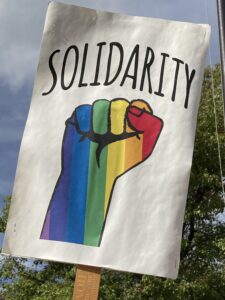 The history of people gathering to protest, or marching to make their minds known, is a long one. Often peaceful by intent, and just as often the last stop before violence, every protest march is one side of a conversation, a monologue inviting dialogue. Or an act of extreme frustration, Not-Power speaking to Power and not being heard. Before this young country came to be, the cry of No taxation without representation fell on deaf ears until a crowd of colonists with anti-royalist sentiments stepped aboard a British ship in Boston Harbor. Wet tea was the result and prosaic as it was, it got someone’s attention.
The history of people gathering to protest, or marching to make their minds known, is a long one. Often peaceful by intent, and just as often the last stop before violence, every protest march is one side of a conversation, a monologue inviting dialogue. Or an act of extreme frustration, Not-Power speaking to Power and not being heard. Before this young country came to be, the cry of No taxation without representation fell on deaf ears until a crowd of colonists with anti-royalist sentiments stepped aboard a British ship in Boston Harbor. Wet tea was the result and prosaic as it was, it got someone’s attention.
I don’t come from a family of marchers. We were taught to vote, yes, but when it came to demonstrating, we were on our own. I grew up in an era of frequent and often bloody demonstrations. Those who marched for civil rights in the ’60s risked every kind of harm. Protestors were clubbed, sprayed with high-pressure hoses, shot at and set upon by dogs. They were rounded up and jailed—often famously. (Martin Luther King Jr. used his time behind bars to write Letter from Birmingham Jail.) And they were killed. Most frequently they were shot to death, including Dr. King himself. In the case of the Freedom Riders, an interracial group of protestors who set out to challenge segregation in the South, the bus they were traveling on was set on fire in an attempt to burn all of them alive.
There is arguably noble intent in every demonstration, a cry for justice serving every different point-of-view. To stand together, walk together, sometimes in silence, sometimes in the dark—this creates a potent connection. I think of it as a groundswell of human bodies clamoring with a shared vision. Hear us! is our request. Take note and remember: Each voice is a vote.
As a nation, we are no longer as comfortable with different points-of-view as we used to be. Dialogue happens infrequently. It is easier, and now acceptable, to spit out a bolus of hatred and call it an argument. And our notion of justice, what is and isn’t right moral behavior, this has become a powder keg to which the highest court in the land too often holds the match.
What is the solution? In a functioning democracy, every voice is heard and every vote counted. Last Saturday I had the opportunity to check in with our democracy, and I have to admit I was not feeling optimistic. It was a warm and sunny Flagstaff day, following a week of intermittent rain. By the time I reached the south lawn of City Hall, more than two hundred people had gathered. Women, men, children and dogs. People with megaphones, microphones. People on bikes and in wheelchairs. And everyone, even the dogs, carried a sign, a clever, funny, angry or frustrated statement of their beliefs.
There’s a real art to creating a good sign. Three words or less, and personal rather than accusatory. No one likes to be accused. It doesn’t lead to dialogue or understanding. Stating your own position without negating somebody else’s—that’s the trick with a sign and it’s the same trick that allows a healthy democracy to function. Demonstrations are intended for only one side of the argument. They are a way to feel good about the position you take, and to feel supported by those who agree with you. Your sign lets people know what team you’re on. Or if the team has a wide angle, your sign advertises your relative position. It’s an announcement of your beliefs and an invitation to engage with those beliefs. Signs are evidence of an open society.
I moved around the crowd taking photos, and everyone I asked was eager to be photographed, pleased that their message had caught my attention. A woman in her sixties carried a homemade sign that read: “I’m STILL protesting this sh**t?!” A man in a purple T-shirt raised a simple white-on-blue sign that read, “Respect Women,” while a gentleman in a Pro Roe T-shirt had some practical advice: “Against abortion? Get a vasectomy.” There were Betty White’s famous words: “If men could get pregnant, abortions would be available at Jiffy Lube,” and RBG’s eloquent paraphrasing of Sarah Moore Grimké’s words: “I ask no favor for my sex. All I ask of our brethren is that they take their feet off our necks.” There were signs in Spanish and English, and a proud sign-bearer from the Satanic Temple. A few crude signs got you thinking, while the angry ones reminded us this isn’t a nicey nice business. Many signs had words so familiar—the same words of decades ago—you had to wonder, is anyone listening?
And there’s the question: Is anyone listening? Why do we stand together and raise our voices if they go unheard? And the answer, to me, may be too simple but it’s the answer I have for now: We stand together to know we are not alone. That’s it. Results not guaranteed.
Down on the lawn I met a woman in her seventies carrying a well-made sign that might have been made years ago and stored in her closet for the time, this time, when she would inevitably need it again. Three words. Defend Abortion Rights. A clear message. Nothing fancy. To my surprise, she told me this was her first demonstration, that she had always been afraid to come out and advertise her beliefs. I asked her how it felt and she said, simply, “It’s time.” She looked happy, proud, as she moved around the crowd with her sign held high. She was not the frustrated woman, nor the angry one, nor the one who wanted to give the patriarchy a piece of her mind. She was a different kind of woman, a different kind of demonstrator, and she carried in her body, in the way she moved, the freedom she’d granted herself, which was and is the way to move democracy forward.

